Abstract
STUDY AIMS: (1) To develop indexes measuring the degree of managedness and the covered benefits of health insurance plans, (2) to describe the variation in these indexes among plans in one health insurance market, (3) to assess the validity of the health plan indexes, and (4) to examine the association between patient characteristics and the health plan indexes. Measures of the "managedness" and covered benefits of health plans are requisite for studying the effects of managed care on clinical practice and health system performance, and they may improve people's understanding of our complex health care system. DATA SOURCES/STUDY SETTING: As part of our larger Physician Referral Study, we collected health insurance information for 189 insurance product lines and 755 products in the Seattle, Washington metropolitan area, which we linked with the study's data for 2,277 patients recruited in local primary care offices. STUDY DESIGN: Managed care and benefit variables were constructed through content analysis of health plan information. Principal component analysis of the variables produced a managedness index, an in-network benefits index, and an out-of-network benefits index. Bivariable analyses examined associations between patient characteristics and the three indexes. PRINCIPAL FINDINGS: From the managed care variables, we constructed three provider-oriented indexes for the financial, utilization management, and network domains of health plans. From these, we constructed a single managedness index, which correlated as expected with the individual measures, with the domain indexes, with plan type (FFS, PPO, POS, HMO), with independent assessments of local experts, and with patients' attitudes about their health insurance. For benefits, we constructed an in-network benefits index and an out-of-network benefits index, which were correlated with the managedness index. The personal characteristics of study patients were associated with the managed care and benefit indexes. Study patients in more managed plans reported somewhat better health than patients in less managed plans. CONCLUSIONS: Indexes of the managedness and benefits of health plans can be constructed from publicly available information. The managedness and benefit indexes are associated with the personal characteristics and health status of study patients. Potential uses of the managed care and benefits indexes are discussed.
Full text
PDF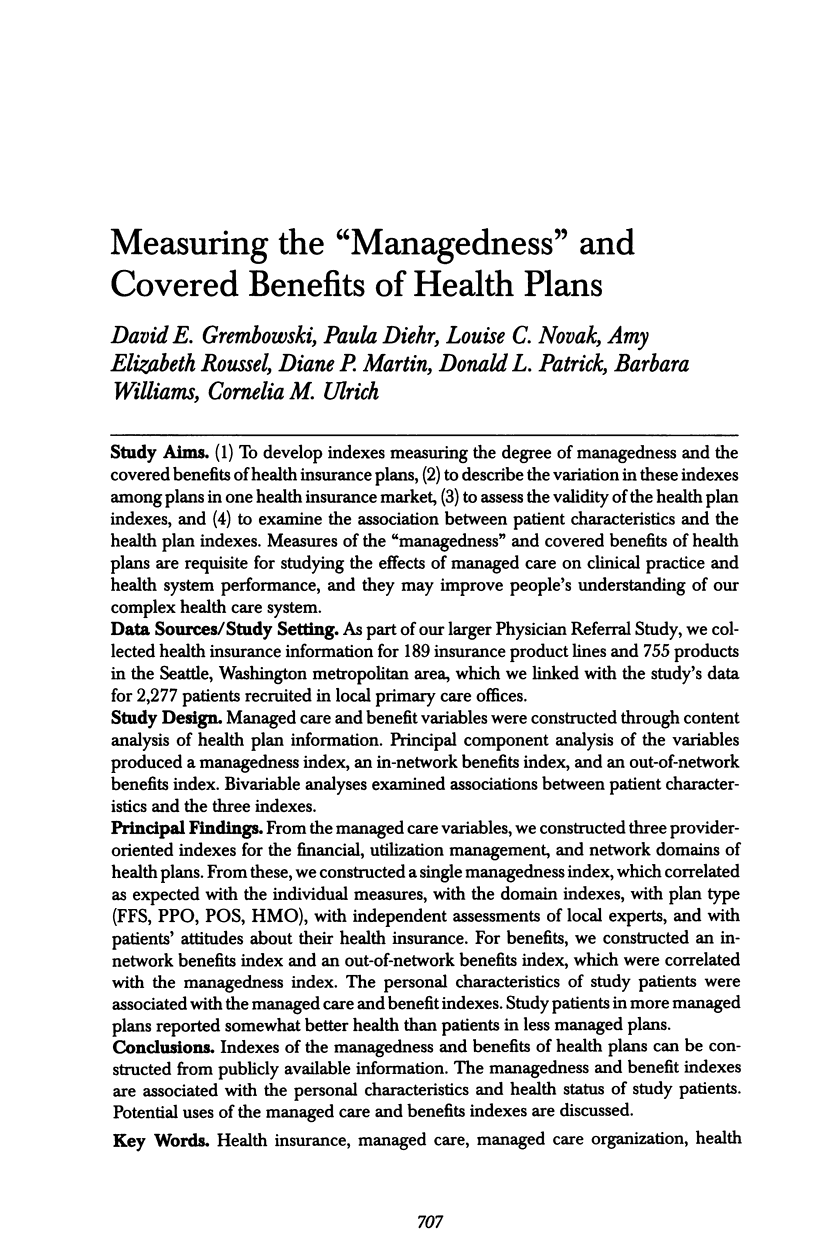
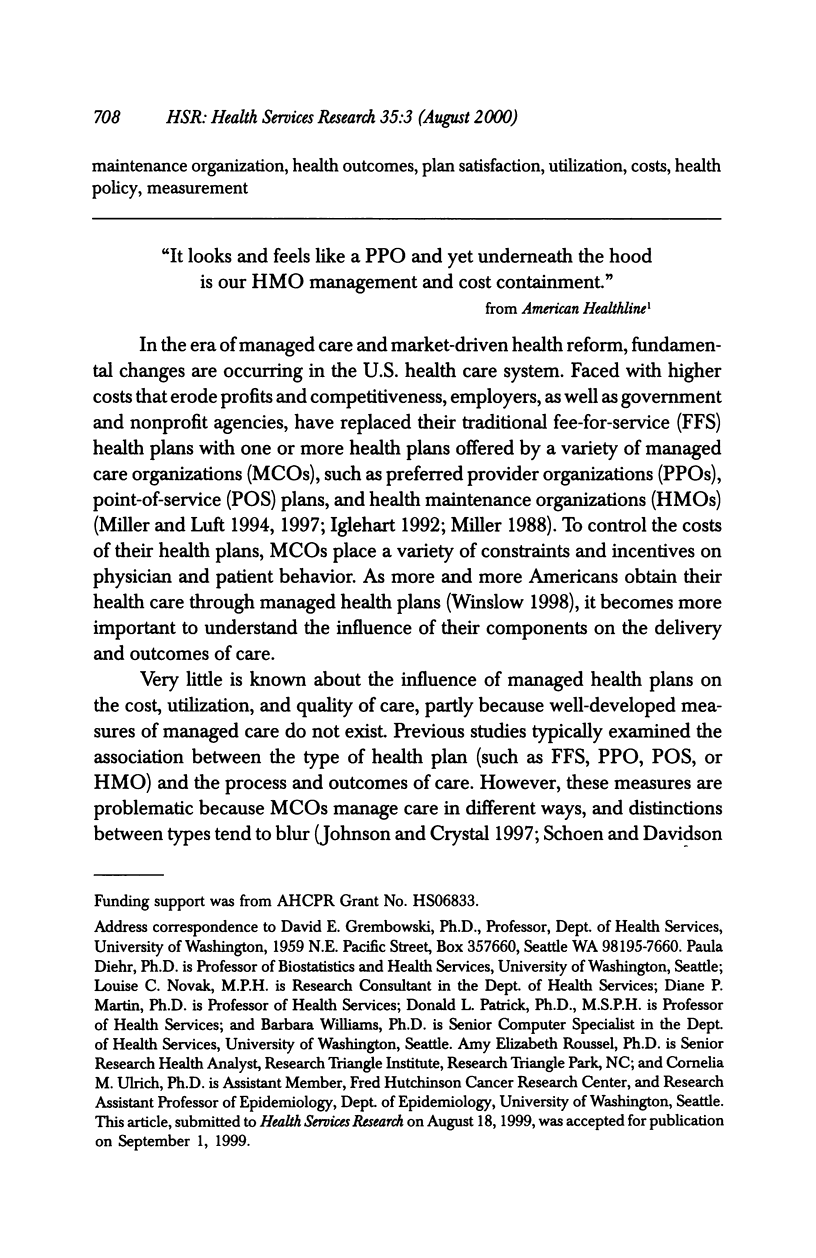
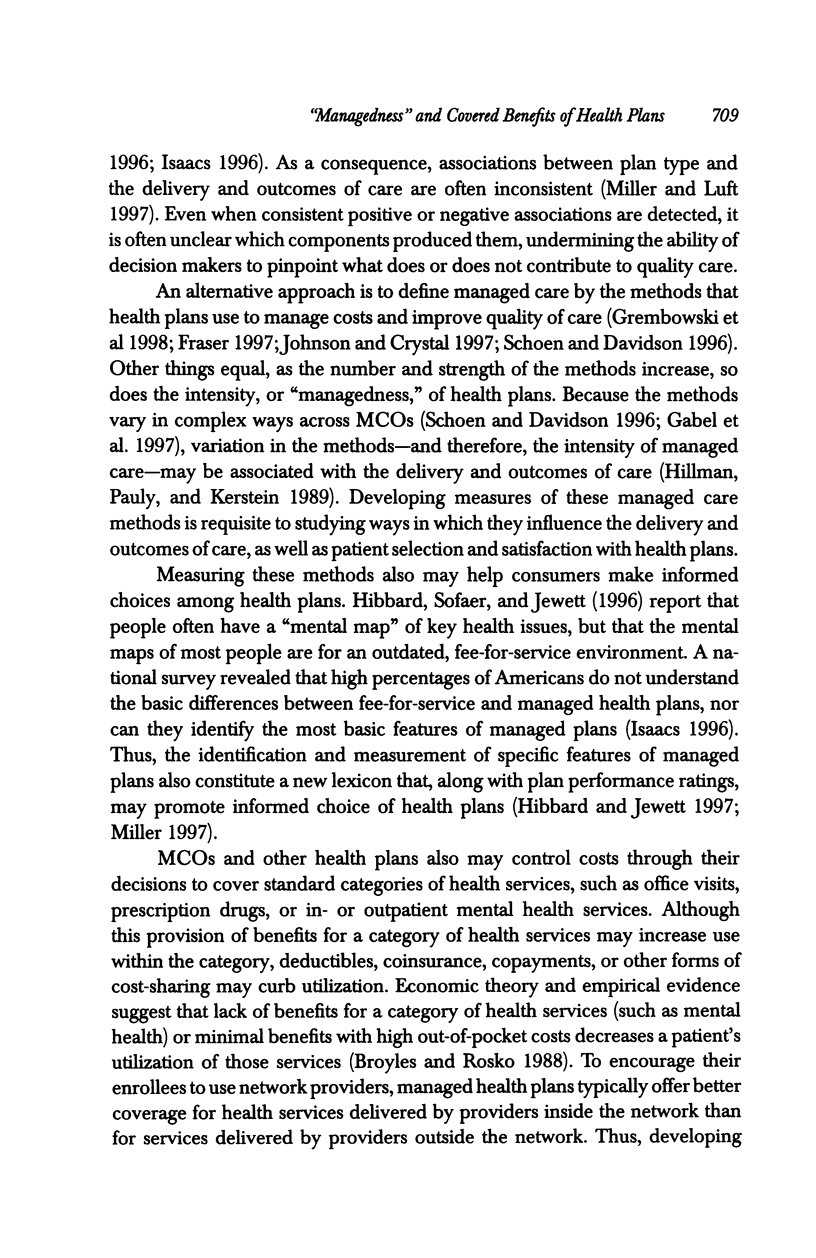

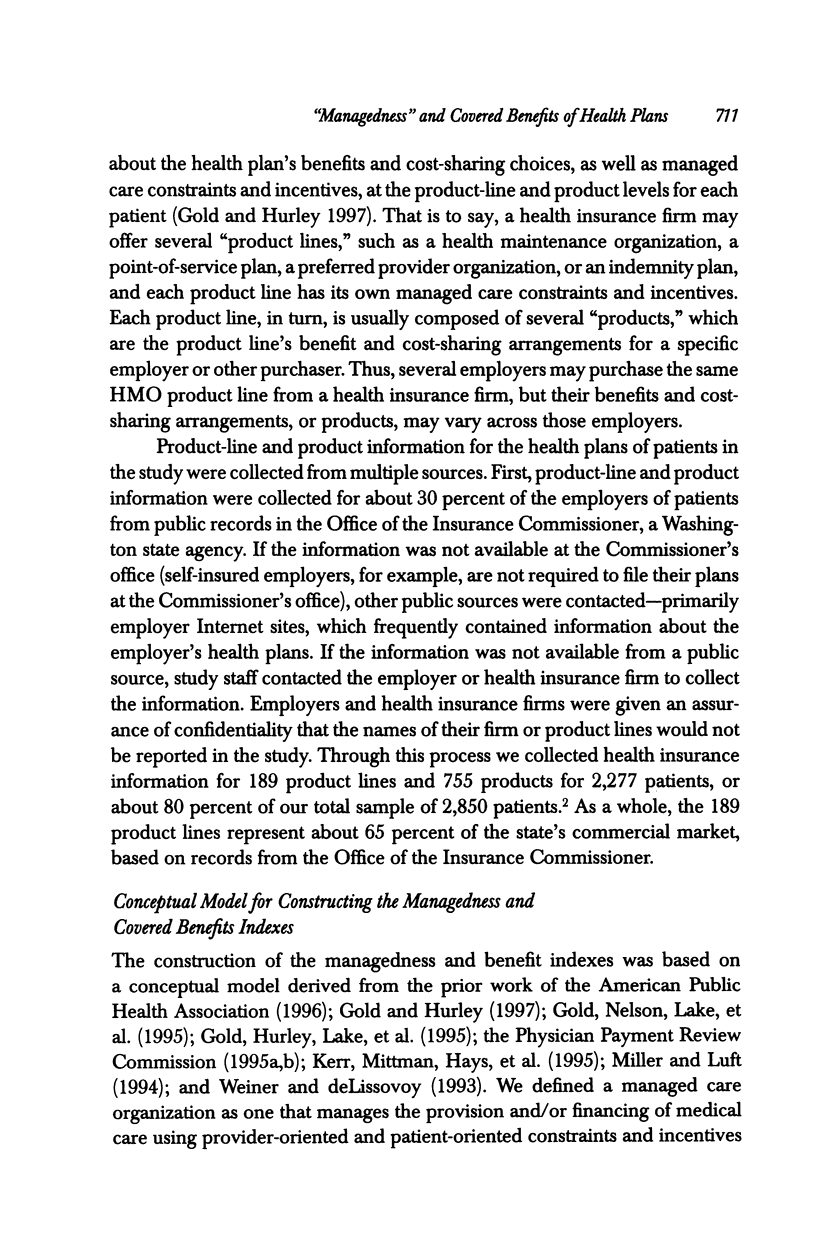
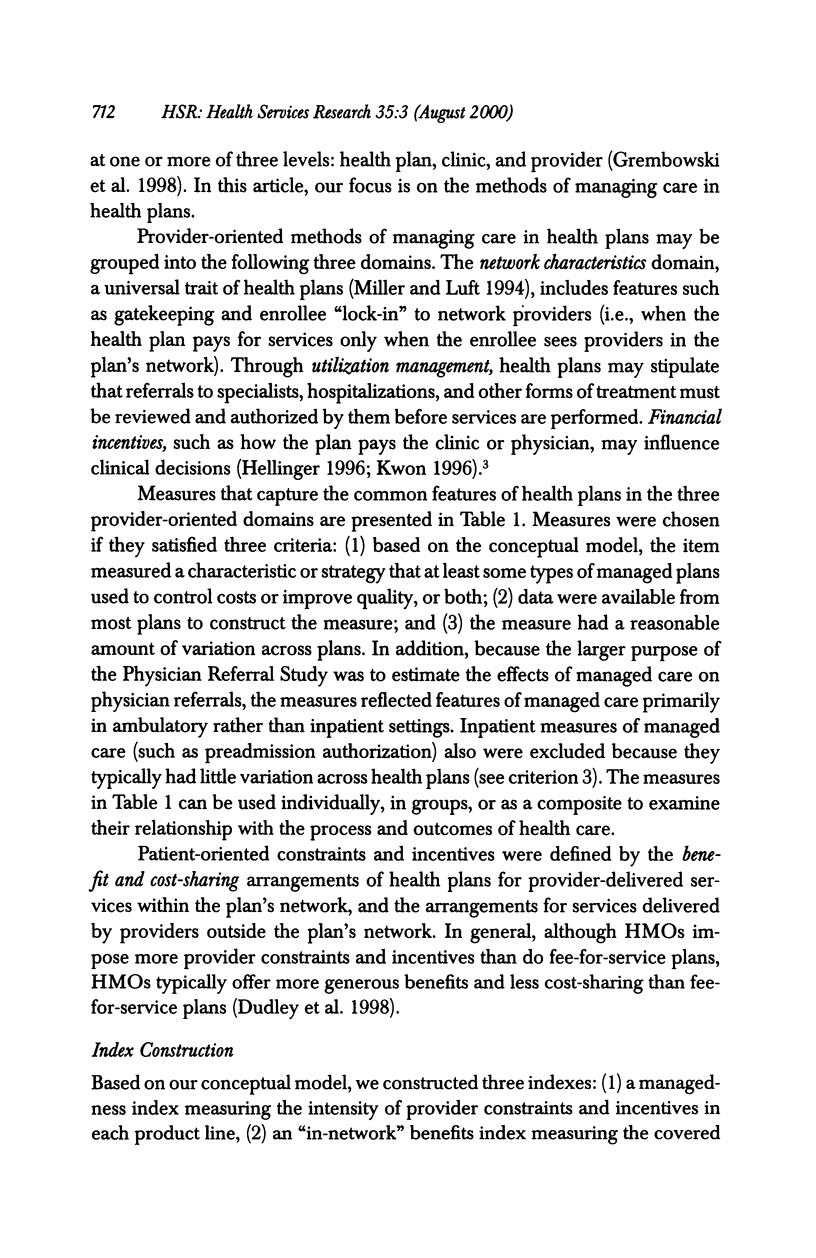
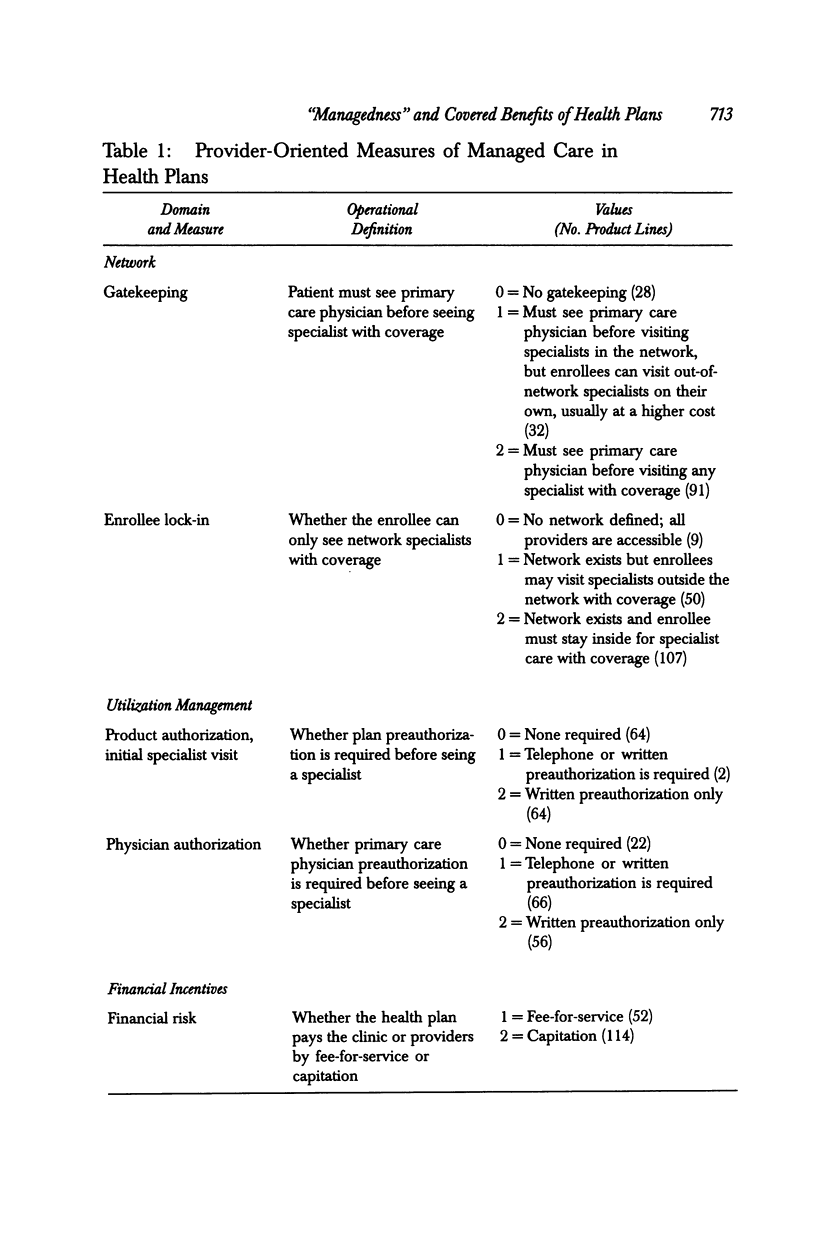
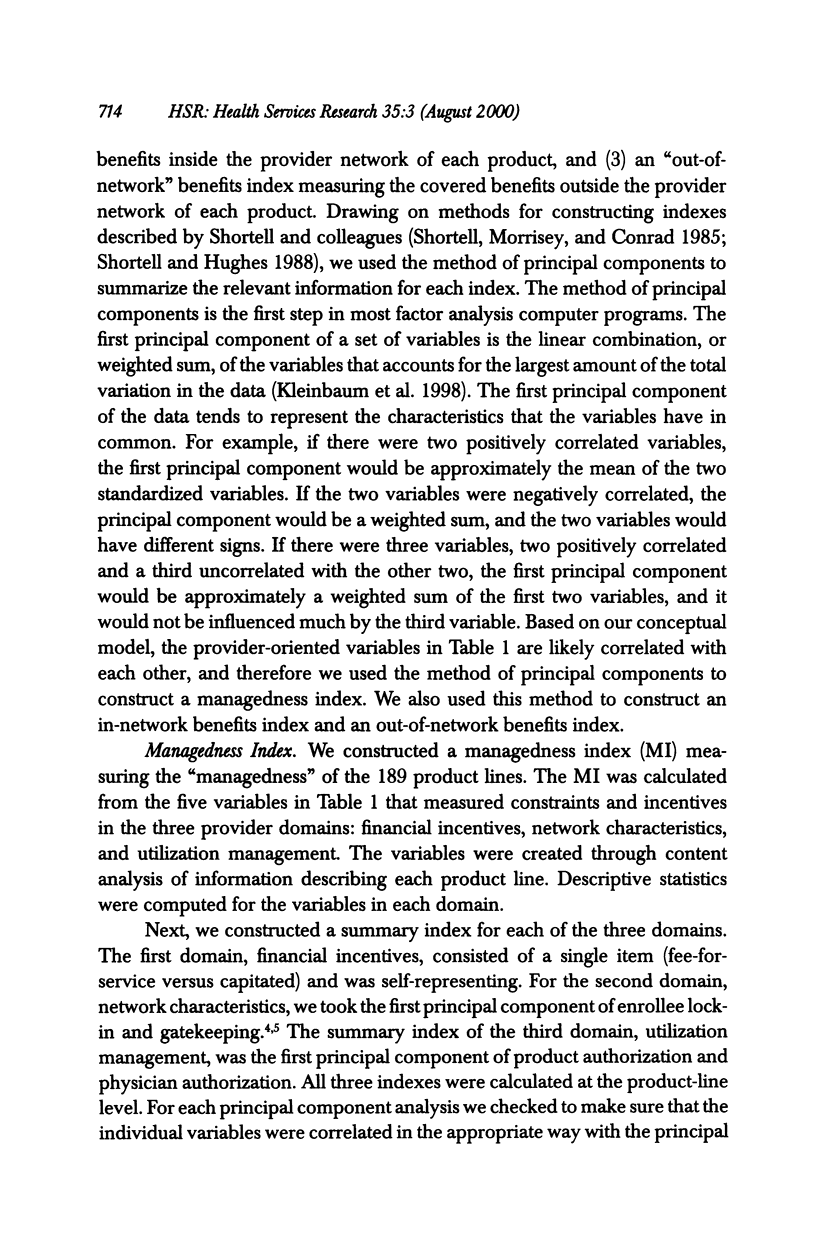
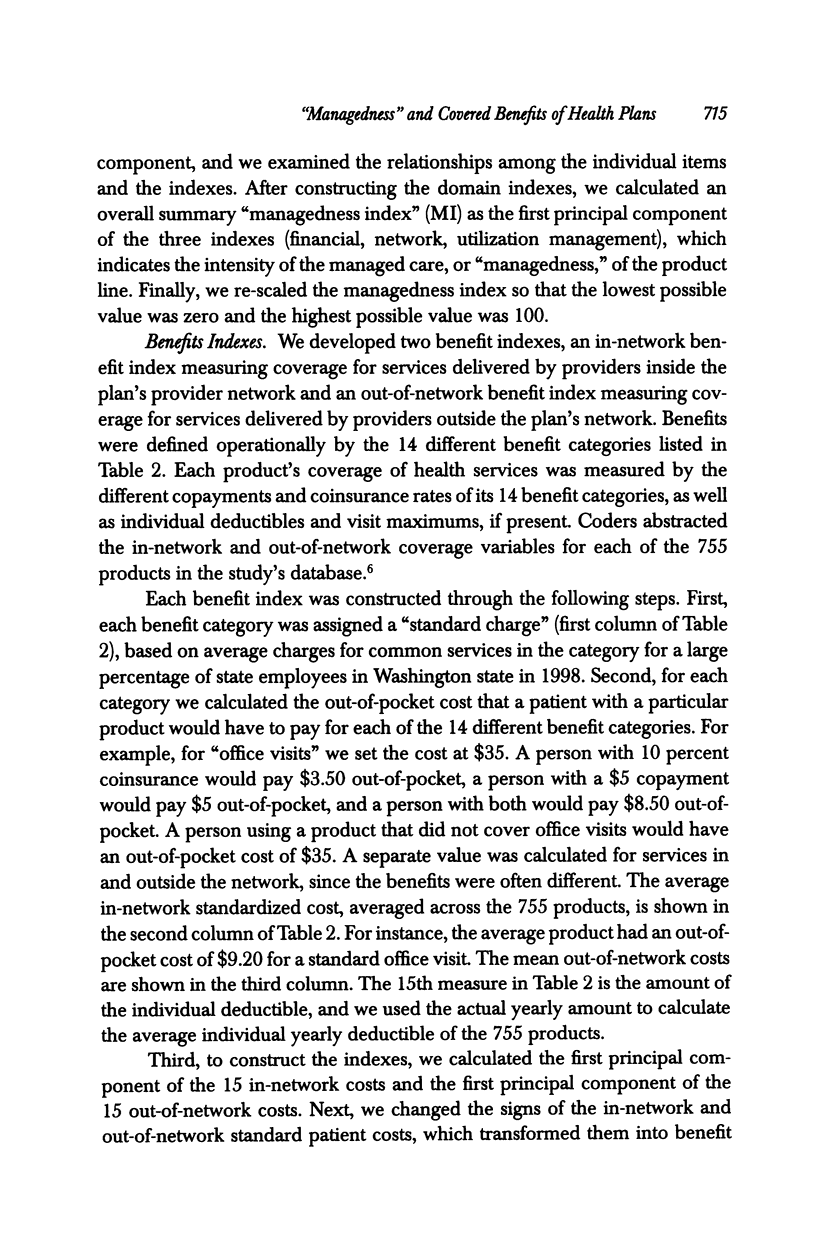
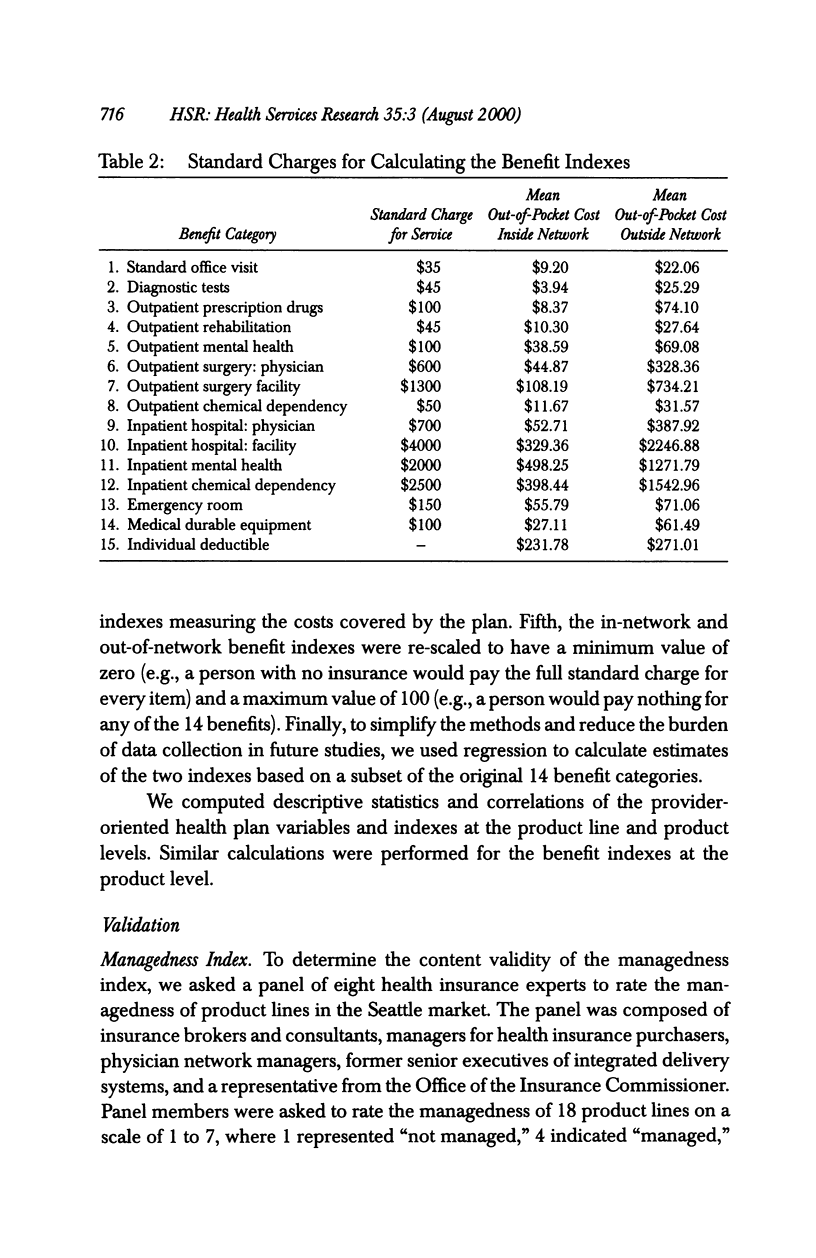
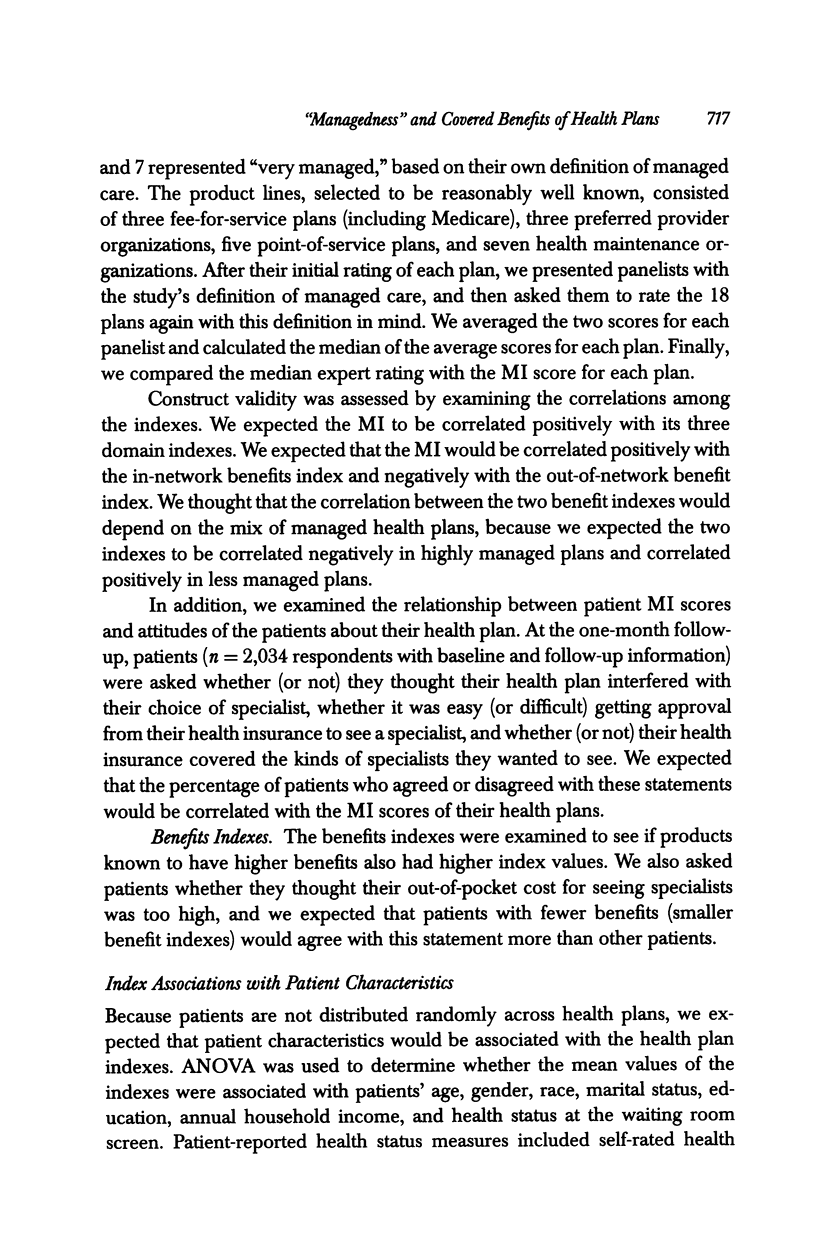
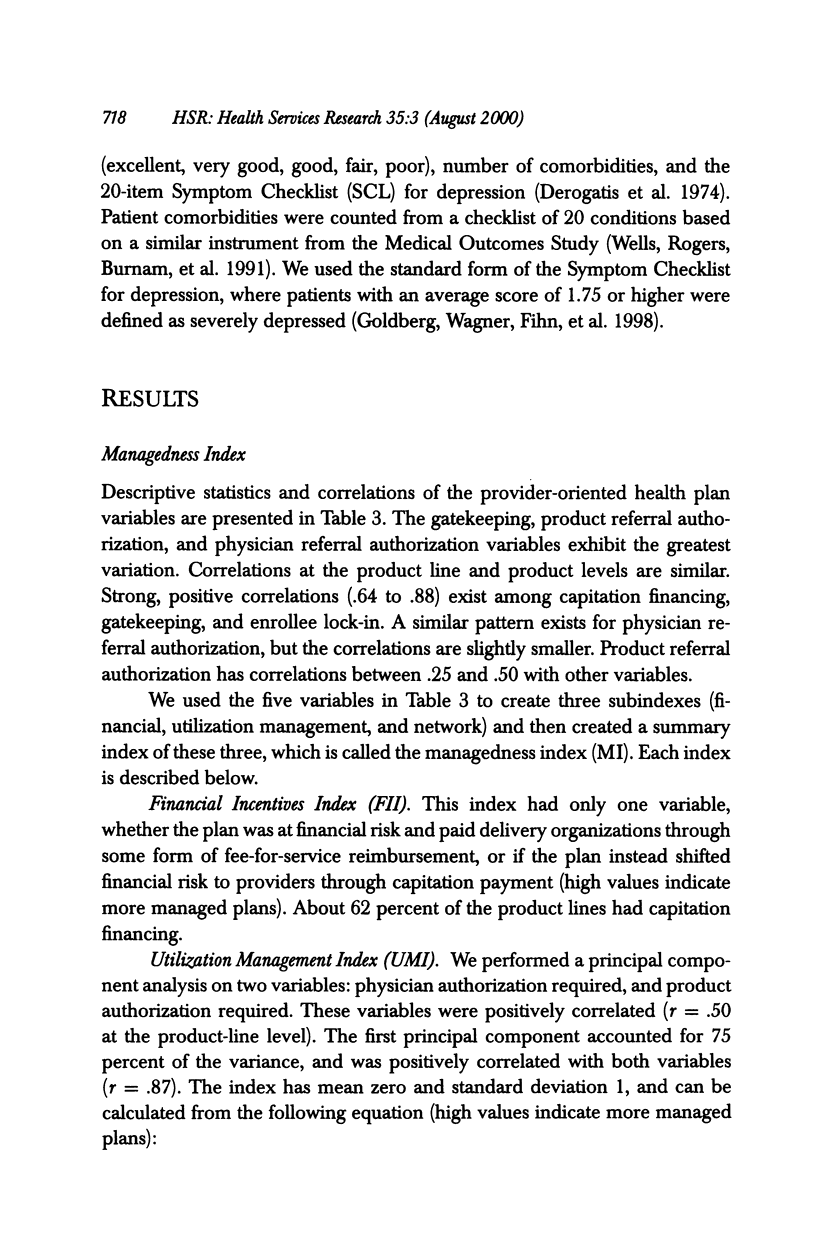
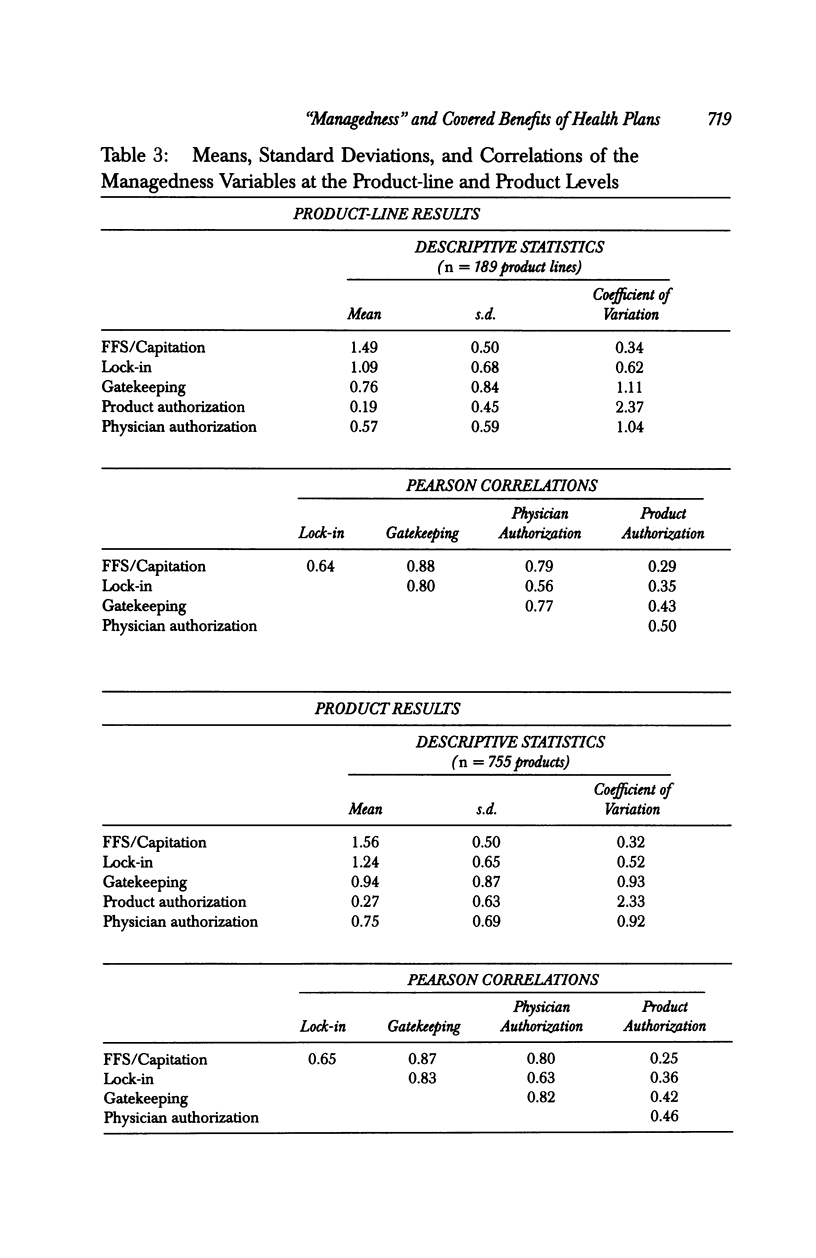
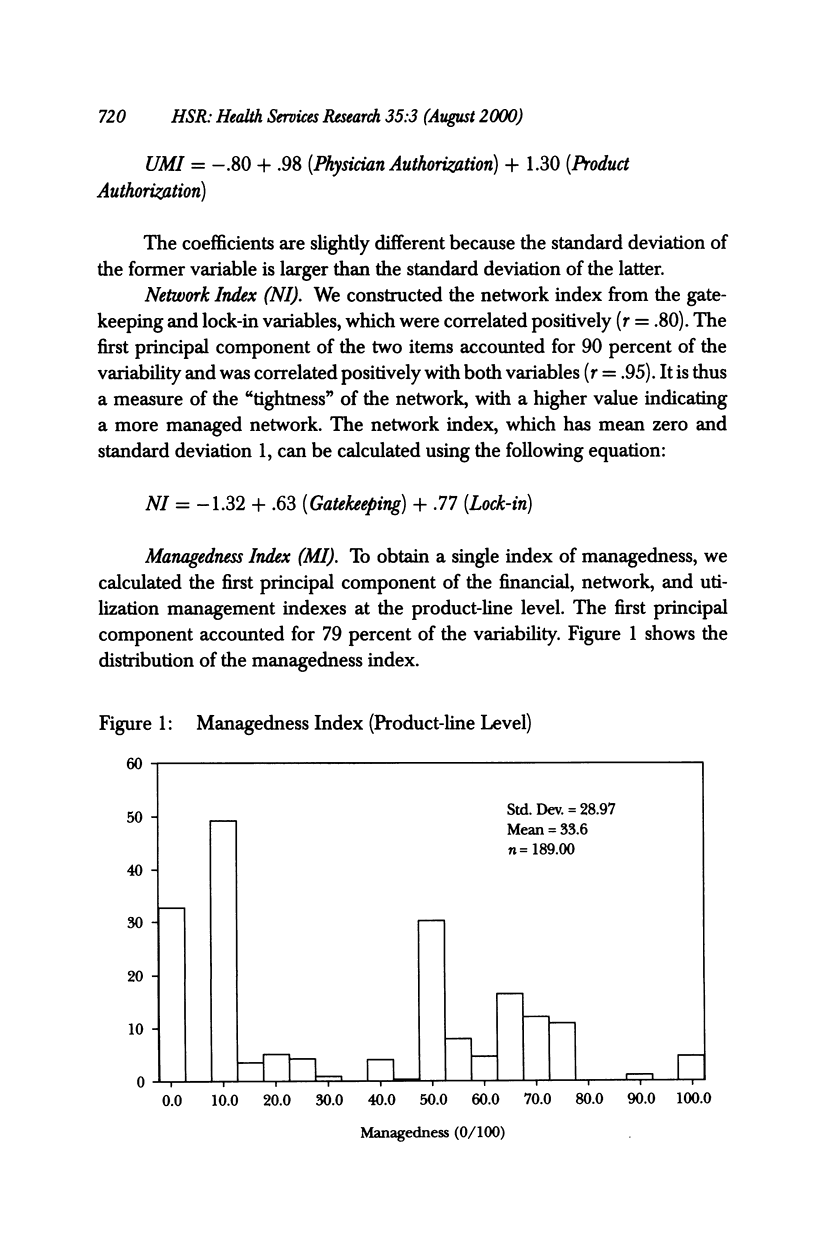

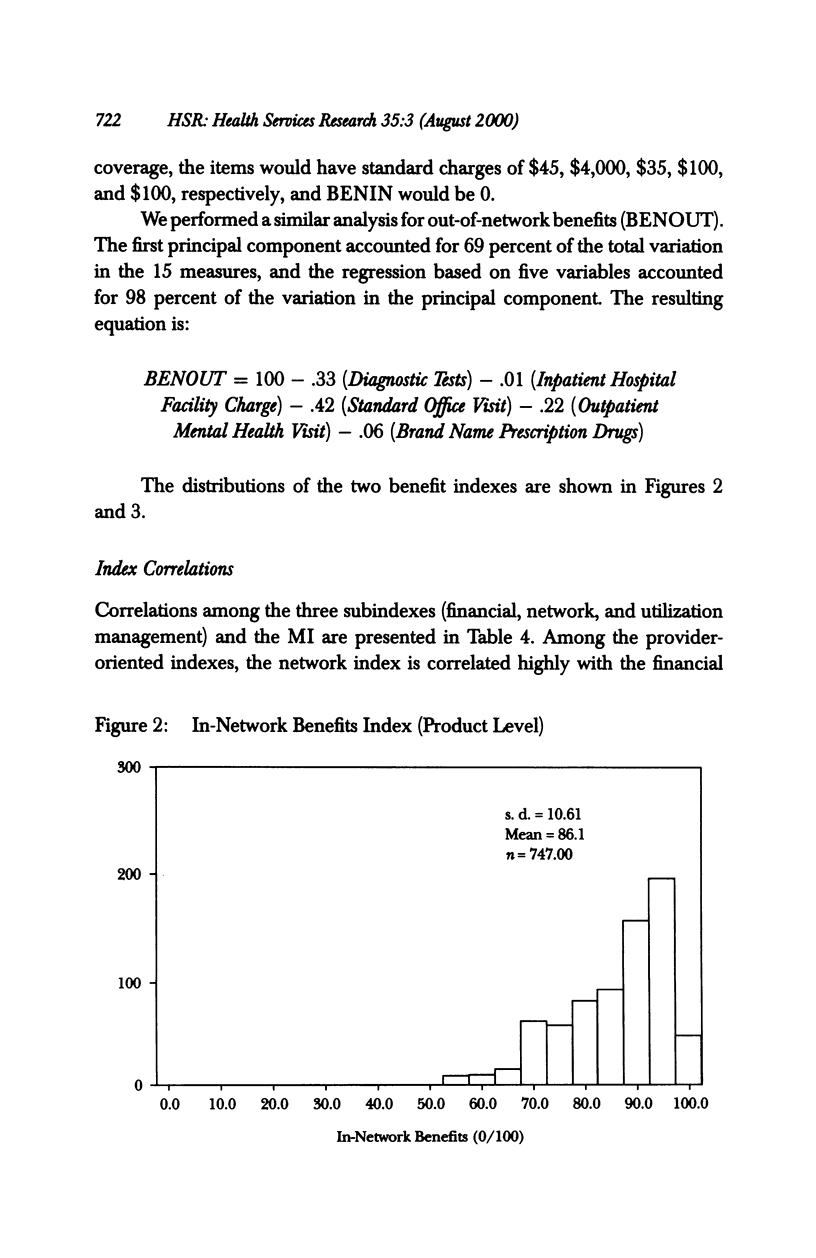
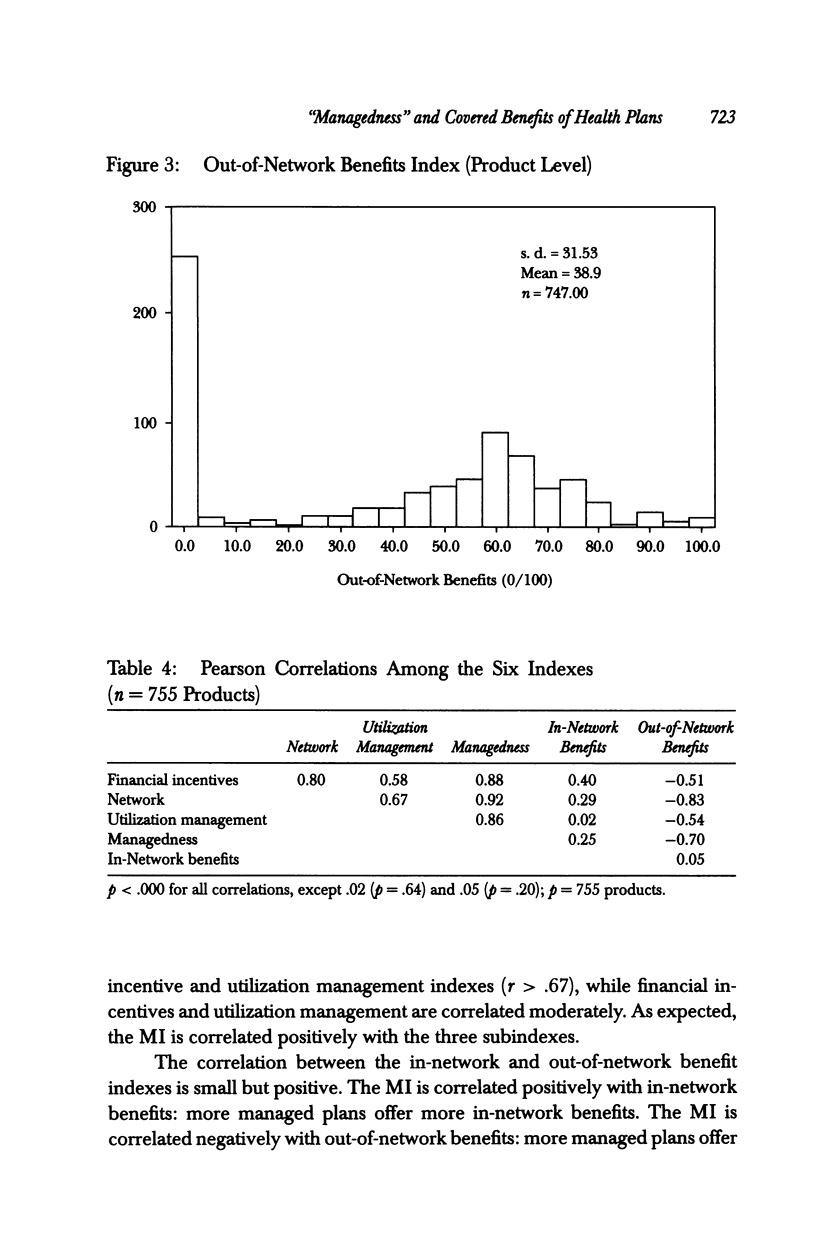
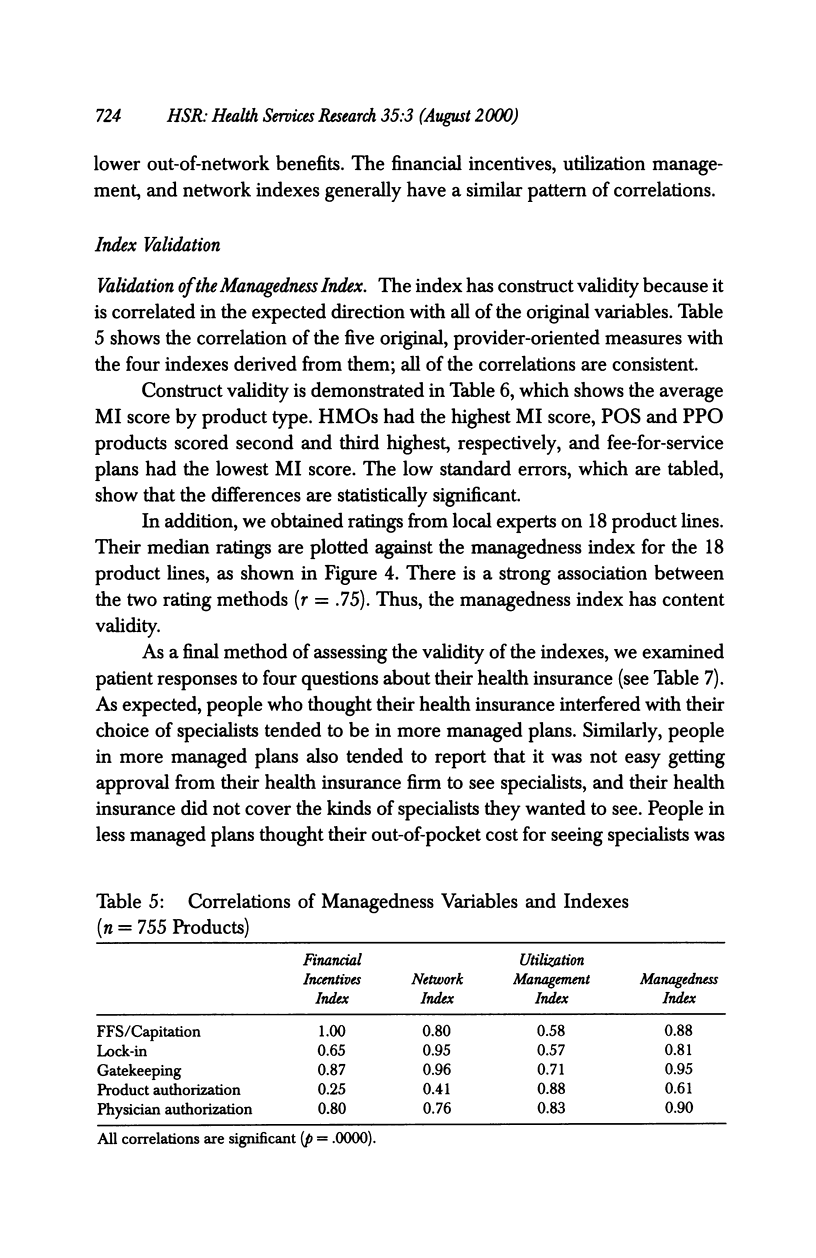
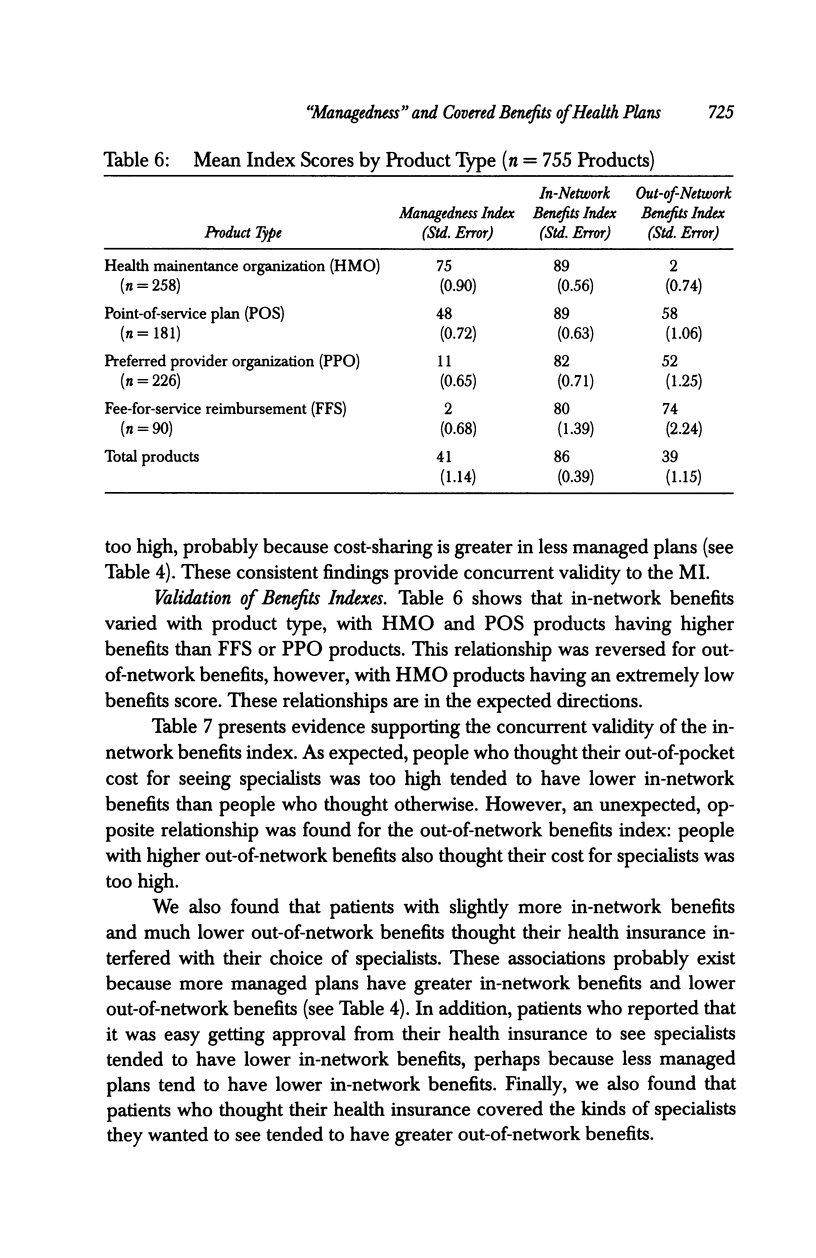
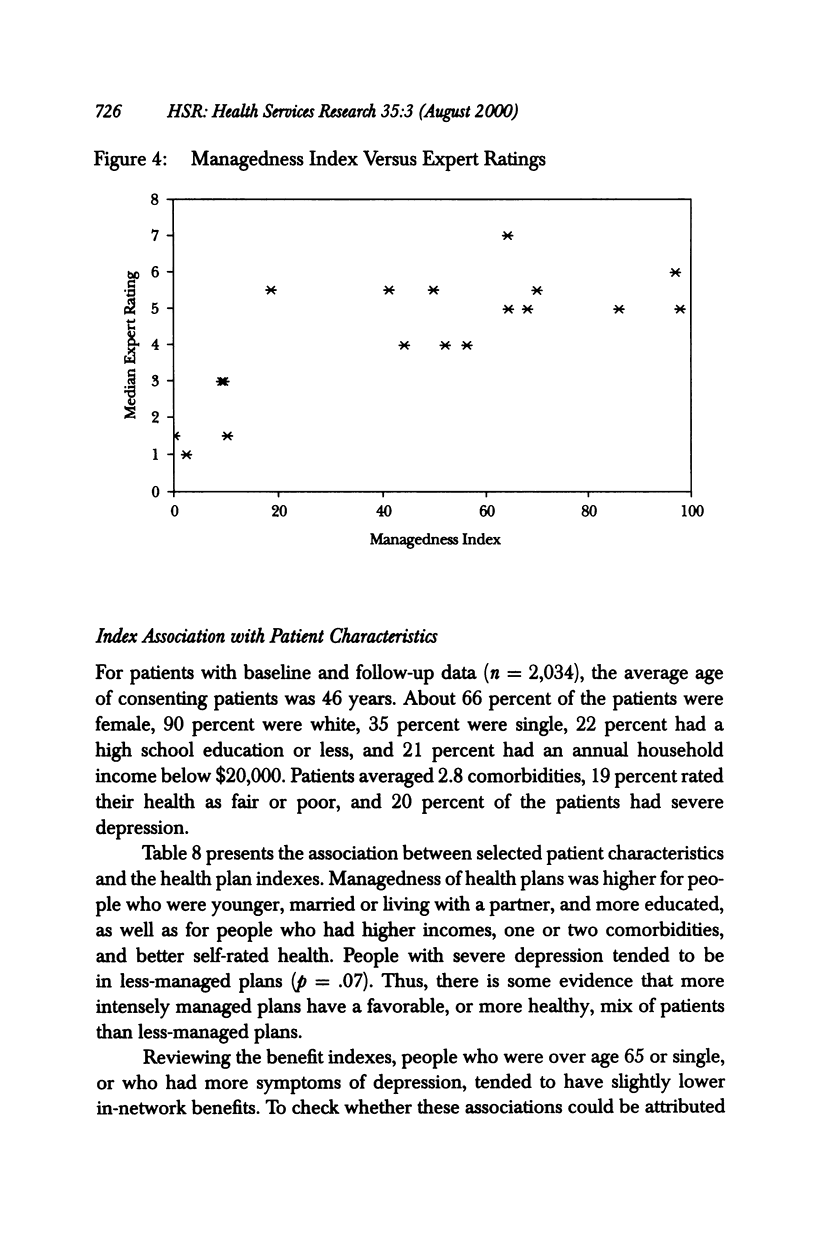
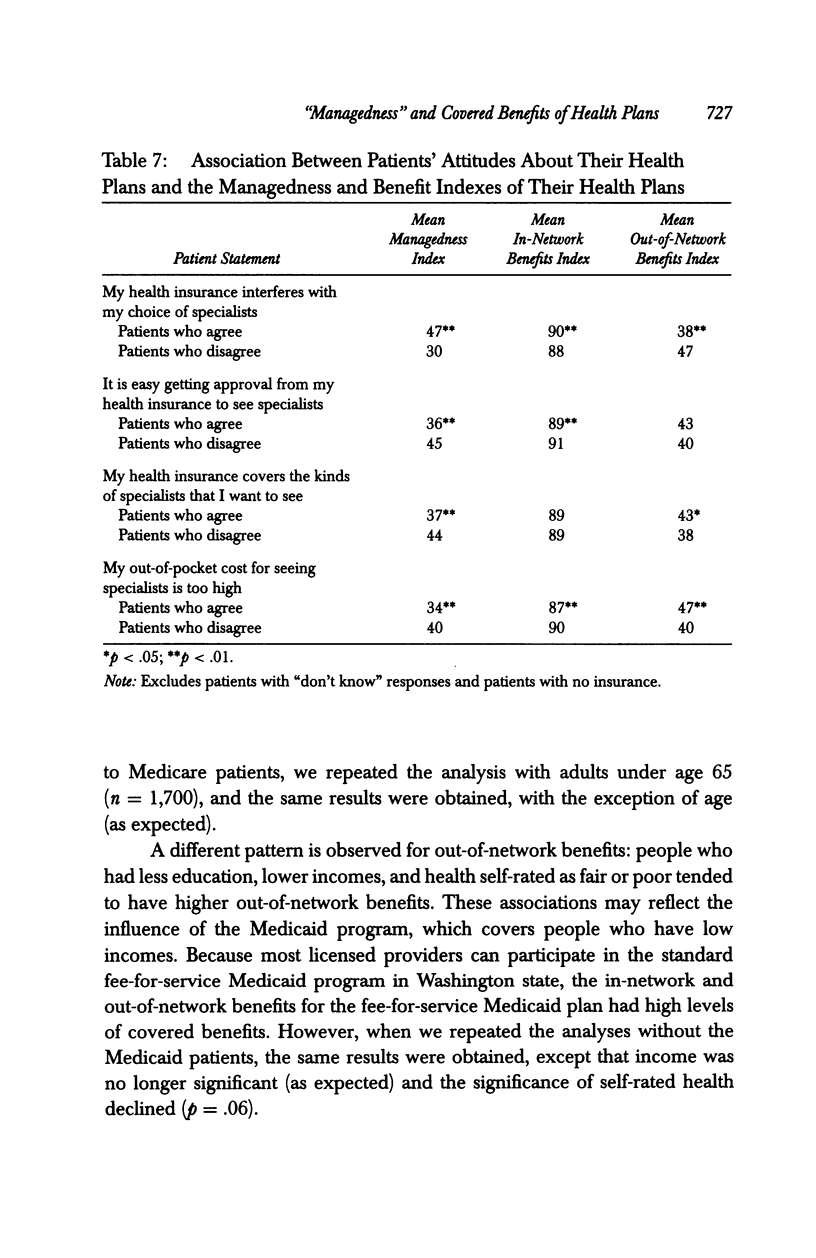
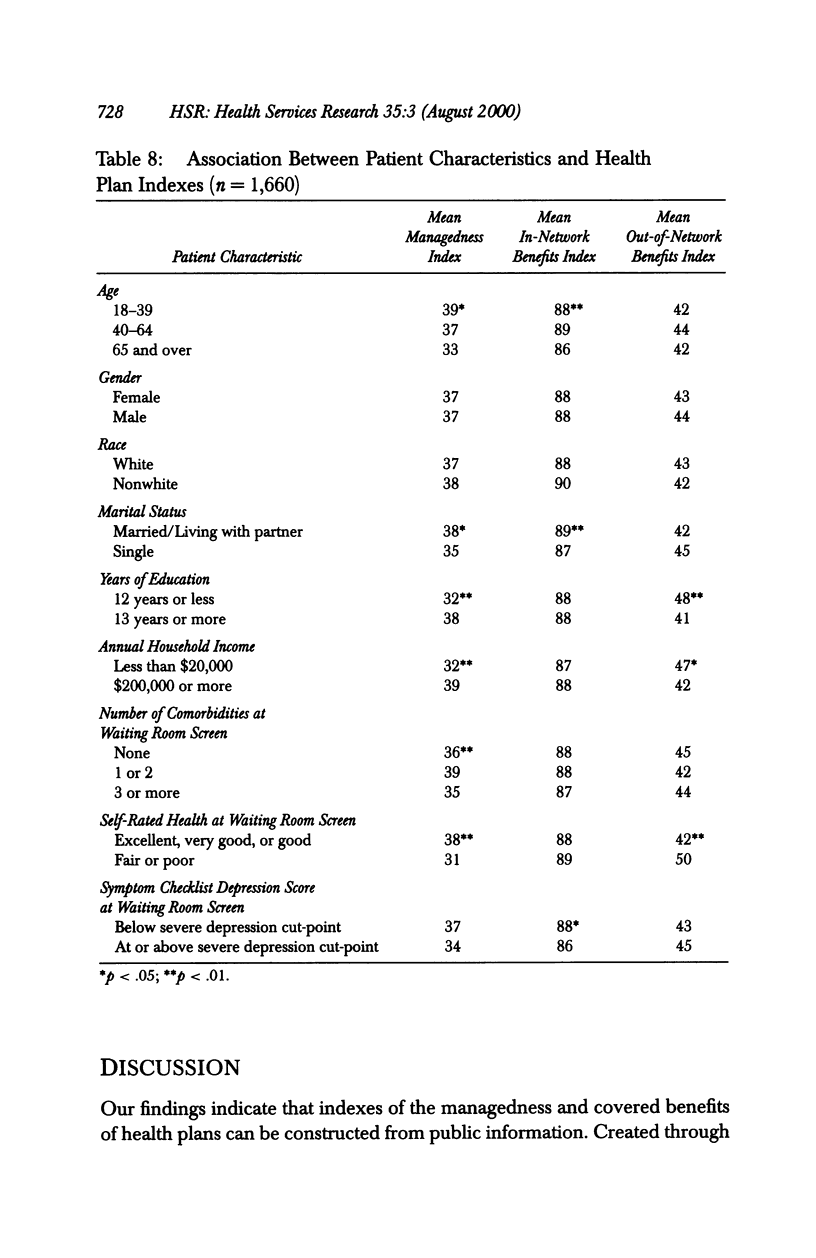
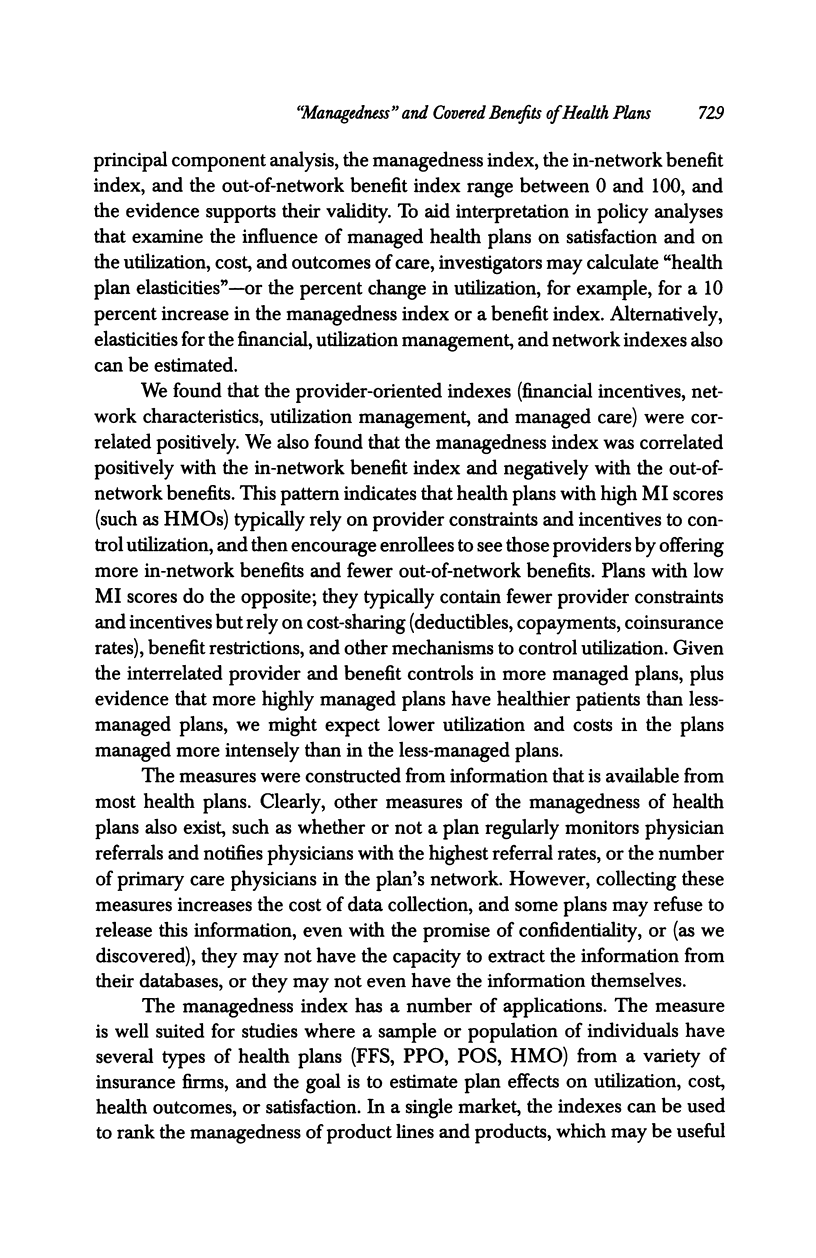
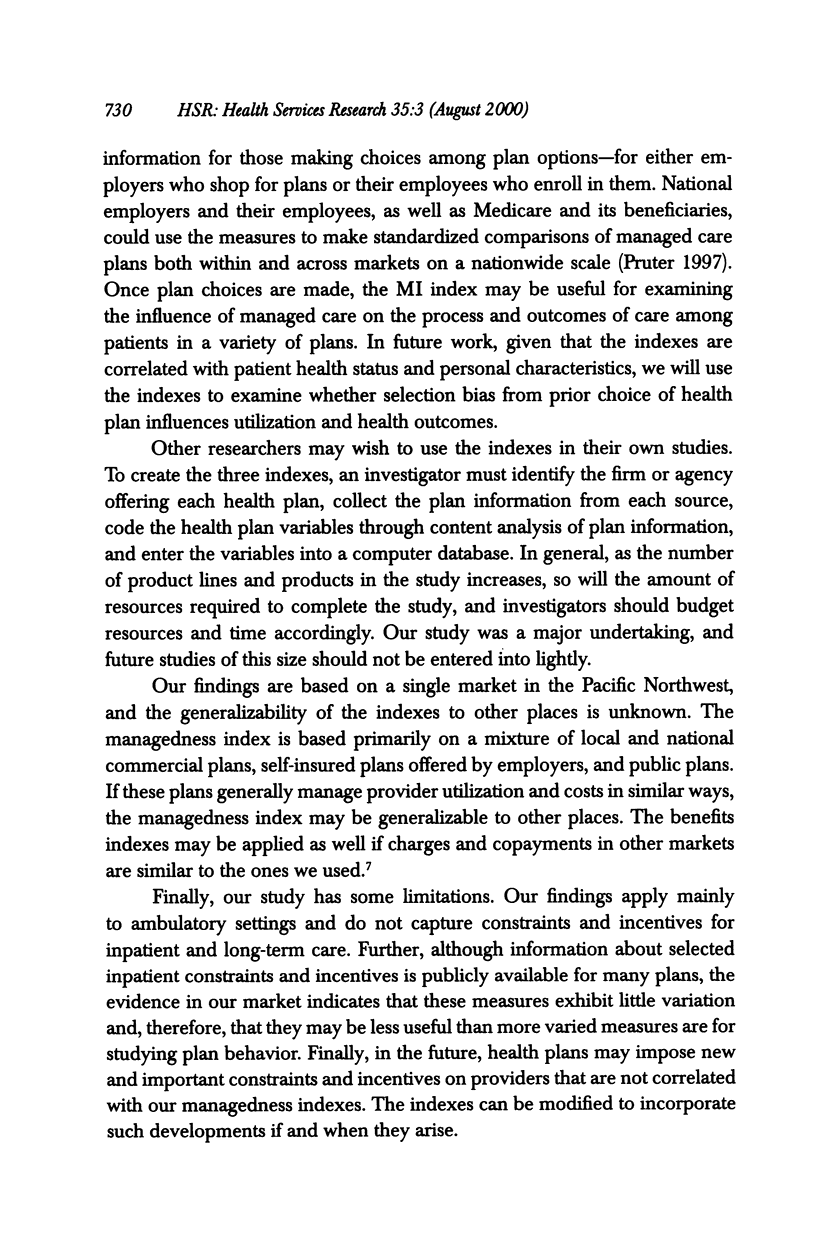
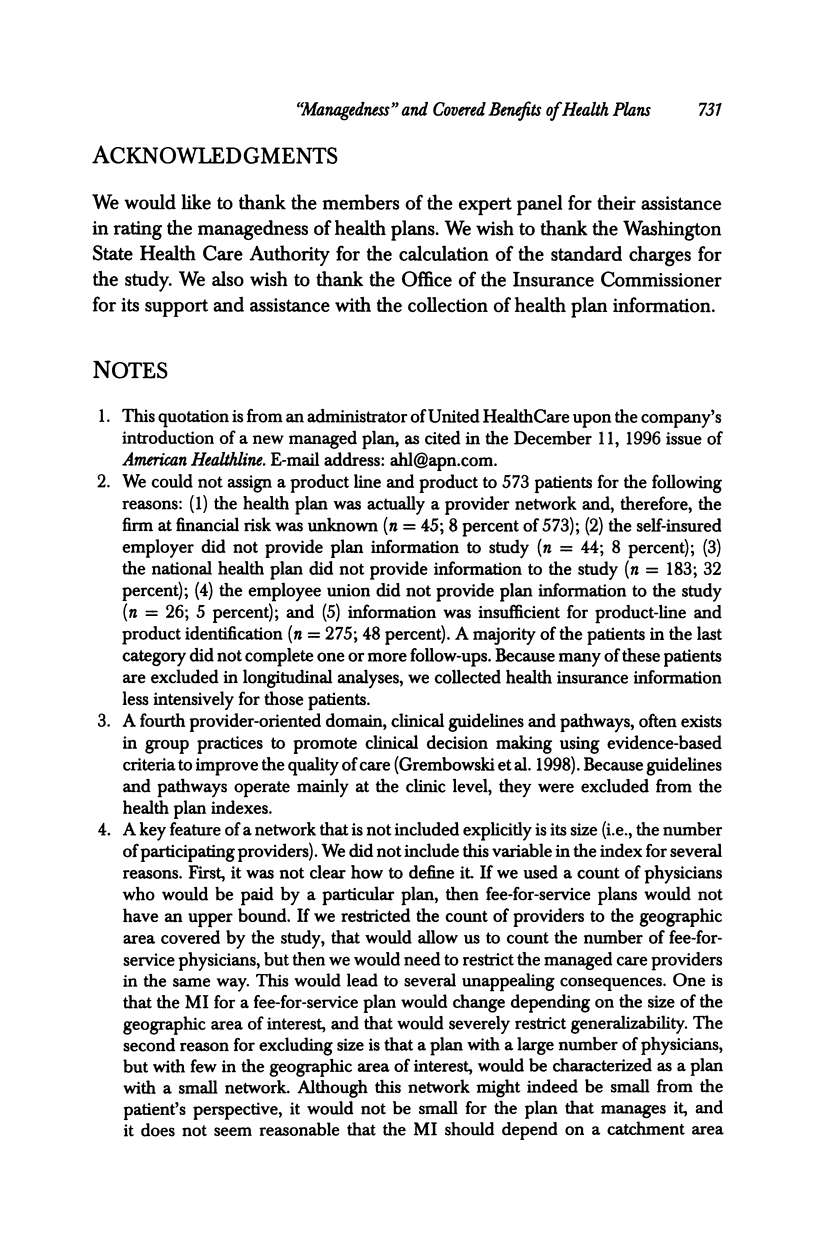
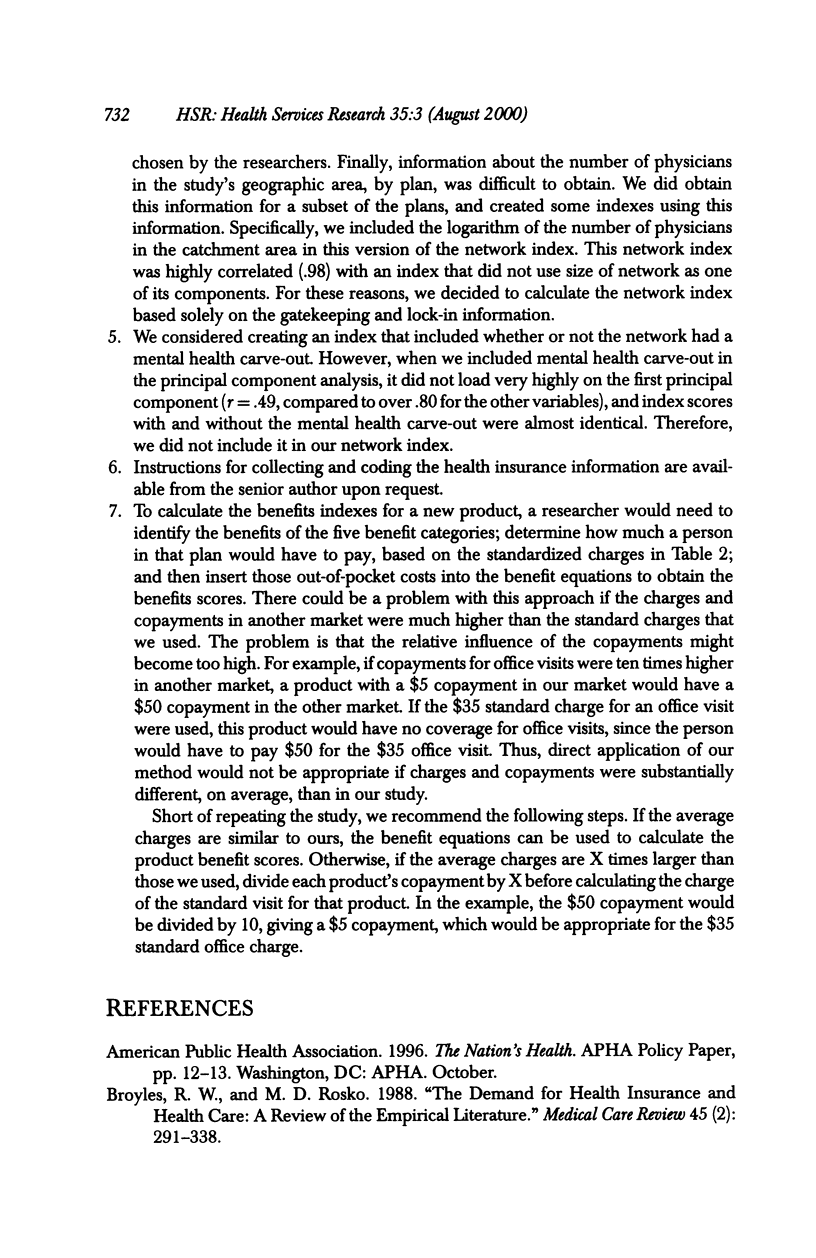
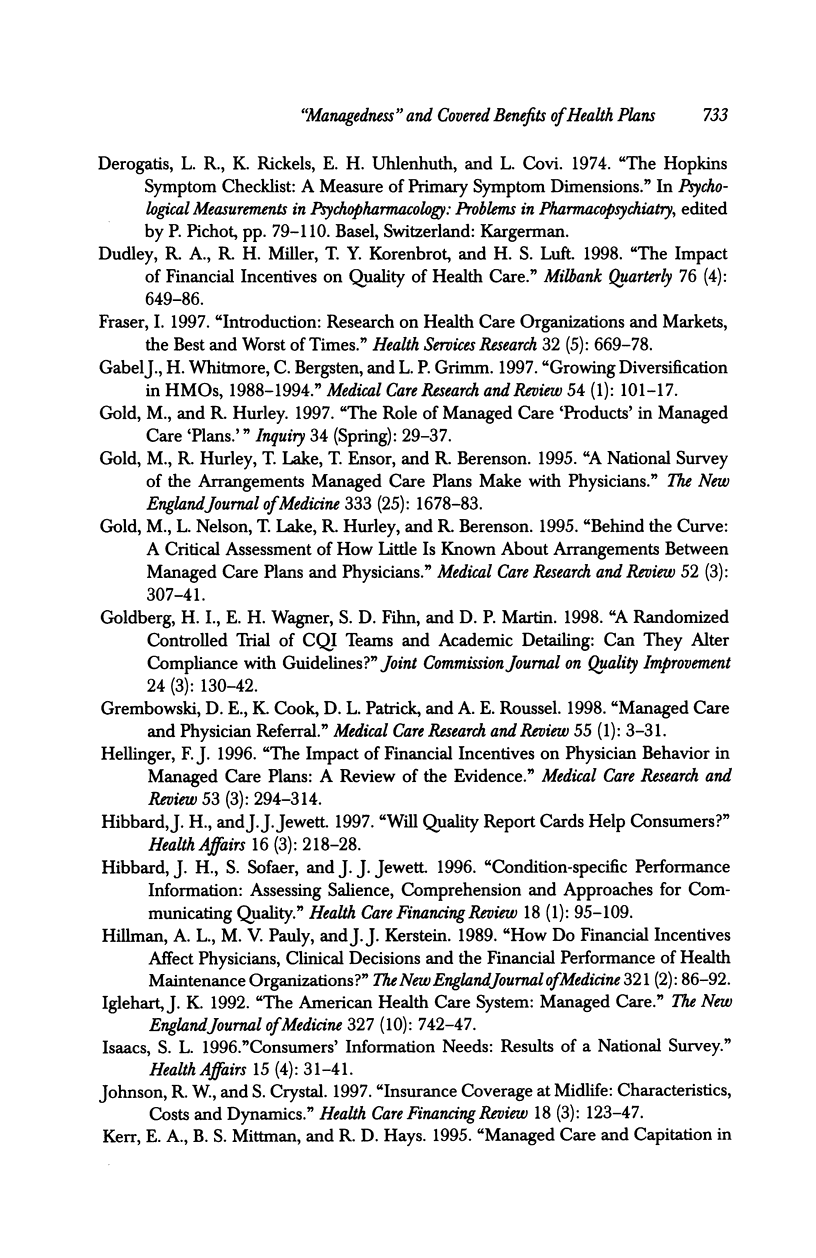

Selected References
These references are in PubMed. This may not be the complete list of references from this article.
- Broyles R. W., Rosko M. D. The demand for health insurance and health care: a review of the empirical literature. Med Care Rev. 1988 Fall;45(2):291–338. doi: 10.1177/107755878804500205. [DOI] [PubMed] [Google Scholar]
- Derogatis L. R., Lipman R. S., Rickels K., Uhlenhuth E. H., Covi L. The Hopkins Symptom Checklist (HSCL). A measure of primary symptom dimensions. Mod Probl Pharmacopsychiatry. 1974;7(0):79–110. doi: 10.1159/000395070. [DOI] [PubMed] [Google Scholar]
- Dudley R. A., Miller R. H., Korenbrot T. Y., Luft H. S. The impact of financial incentives on quality of health care. Milbank Q. 1998;76(4):649-86, 511. doi: 10.1111/1468-0009.00109. [DOI] [PMC free article] [PubMed] [Google Scholar]
- Fraser I. Introduction: research on health care organizations and markets--the best and worst of times. Health Serv Res. 1997 Dec;32(5):669–678. [PMC free article] [PubMed] [Google Scholar]
- Gabel J., Whitmore H., Bergsten C., Grimm L. P. Growing diversification in HMOs, 1988-1994. Med Care Res Rev. 1997 Mar;54(1):101–117. doi: 10.1177/107755879705400106. [DOI] [PubMed] [Google Scholar]
- Gold M. R., Hurley R., Lake T., Ensor T., Berenson R. A national survey of the arrangements managed-care plans make with physicians. N Engl J Med. 1995 Dec 21;333(25):1678–1683. doi: 10.1056/NEJM199512213332505. [DOI] [PubMed] [Google Scholar]
- Gold M., Hurley R. The role of managed care "products" in managed care "plans". Inquiry. 1997 Spring;34(1):29–37. [PubMed] [Google Scholar]
- Gold M., Nelson L., Lake T., Hurley R., Berenson R. Behind the curve: a critical assessment of how little is known about arrangements between managed care plans and physicians. Med Care Res Rev. 1995 Sep;52(3):307–341. doi: 10.1177/107755879505200301. [DOI] [PubMed] [Google Scholar]
- Goldberg H. I., Wagner E. H., Fihn S. D., Martin D. P., Horowitz C. R., Christensen D. B., Cheadle A. D., Diehr P., Simon G. A randomized controlled trial of CQI teams and academic detailing: can they alter compliance with guidelines? Jt Comm J Qual Improv. 1998 Mar;24(3):130–142. doi: 10.1016/s1070-3241(16)30367-4. [DOI] [PubMed] [Google Scholar]
- Grembowski D. E., Cook K., Patrick D. L., Roussel A. E. Managed care and physician referral. Med Care Res Rev. 1998 Mar;55(1):3–31. doi: 10.1177/107755879805500101. [DOI] [PubMed] [Google Scholar]
- Hellinger F. J. The impact of financial incentives on physician behavior in managed care plans: a review of the evidence. Med Care Res Rev. 1996 Sep;53(3):294–314. doi: 10.1177/107755879605300305. [DOI] [PubMed] [Google Scholar]
- Hibbard J. H., Jewett J. J. Will quality report cards help consumers? Health Aff (Millwood) 1997 May-Jun;16(3):218–228. doi: 10.1377/hlthaff.16.3.218. [DOI] [PubMed] [Google Scholar]
- Hibbard J. H., Sofaer S., Jewett J. J. Condition-specific performance information: assessing salience, comprehension, and approaches for communicating quality. Health Care Financ Rev. 1996 Fall;18(1):95–109. [PMC free article] [PubMed] [Google Scholar]
- Hillman A. L., Pauly M. V., Kerstein J. J. How do financial incentives affect physicians' clinical decisions and the financial performance of health maintenance organizations? N Engl J Med. 1989 Jul 13;321(2):86–92. doi: 10.1056/NEJM198907133210205. [DOI] [PubMed] [Google Scholar]
- Iglehart J. K. The American health care system. Managed care. N Engl J Med. 1992 Sep 3;327(10):742–747. doi: 10.1056/NEJM199209033271029. [DOI] [PubMed] [Google Scholar]
- Isaacs S. L. Consumer's information needs: results of a national survey. Health Aff (Millwood) 1996 Winter;15(4):31–41. doi: 10.1377/hlthaff.15.4.31. [DOI] [PubMed] [Google Scholar]
- Johnson R. W., Crystal S. Health insurance coverage at midlife: characteristics, costs, and dynamics. Health Care Financ Rev. 1997 Spring;18(3):123–148. [PMC free article] [PubMed] [Google Scholar]
- Kwon S. Structure of financial incentive systems for providers in managed care plans. Med Care Res Rev. 1996 Jun;53(2):149–161. doi: 10.1177/107755879605300202. [DOI] [PubMed] [Google Scholar]
- Miller F. H. Vertical restraints and powerful health insurers: exclusionary conduct masquerading as managed care? Law Contemp Probl. 1988 Spring;51(2):195–236. [PubMed] [Google Scholar]
- Miller R. H., Luft H. S. Does managed care lead to better or worse quality of care? Health Aff (Millwood) 1997 Sep-Oct;16(5):7–25. doi: 10.1377/hlthaff.16.5.7. [DOI] [PubMed] [Google Scholar]
- Miller T. E. Managed care regulation: in the laboratory of the states. JAMA. 1997 Oct 1;278(13):1102–1109. doi: 10.1001/jama.278.13.1102. [DOI] [PubMed] [Google Scholar]
- Shortell S. M., Hughes E. F. The effects of regulation, competition, and ownership on mortality rates among hospital inpatients. N Engl J Med. 1988 Apr 28;318(17):1100–1107. doi: 10.1056/NEJM198804283181705. [DOI] [PubMed] [Google Scholar]
- Shortell S. M., Morrisey M. A., Conrad D. A. Economic regulation and hospital behavior: the effects on medical staff organization and hospital-physician relationships. Health Serv Res. 1985 Dec;20(5):597–628. [PMC free article] [PubMed] [Google Scholar]
- Wells K. B., Rogers W., Burnam A., Greenfield S., Ware J. E., Jr How the medical comorbidity of depressed patients differs across health care settings: results from the Medical Outcomes Study. Am J Psychiatry. 1991 Dec;148(12):1688–1696. doi: 10.1176/ajp.148.12.1688. [DOI] [PubMed] [Google Scholar]


